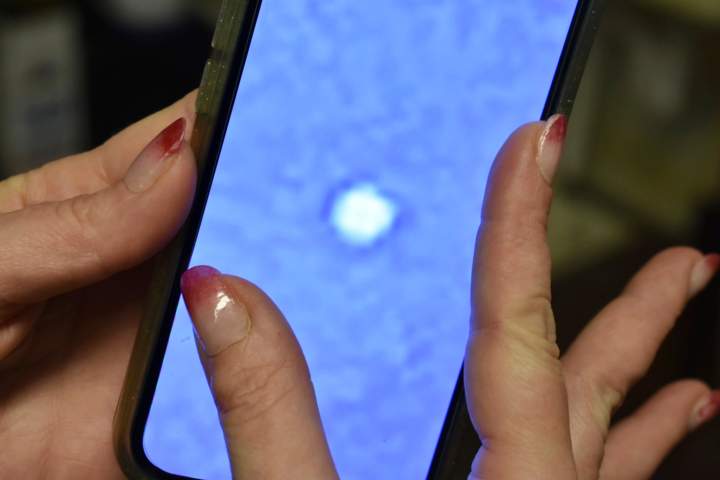Science
Canada Urged to Enhance UFO Data Collection and Analysis

A report from the federal science adviser emphasizes the need for systematic government collection and analysis of data regarding unidentified aerial phenomena (UAP) in Canada. This initiative aims to enhance the country’s preparedness for incidents similar to the appearance of high-altitude balloons over North America in early 2023, one of which originated from China and carried advanced equipment. These balloon events sparked significant public speculation before gradually disappearing from the news cycle.
The final report from the science adviser’s Sky Canada Project underscores the challenges in distinguishing between natural occurrences, common technological devices, and potential security threats in the sky. Released this week, the report advocates for the Canadian government to designate a federal department or agency to manage public data on celestial sightings. It also recommends establishing a service for collecting testimonies, investigating cases, and disseminating analyses.
Public Fascination and the Shift to UAP Terminology
The report delves into the long-standing public interest in unidentified flying objects and their associations with extraterrestrial life. It highlights a recent shift towards the broader terminology of UAPs, suggesting that this evolution could mitigate the skepticism that has often surrounded UFO sightings.
“Stigmatization can have significant consequences, such as discouraging witnesses from coming forward and hindering scientific inquiry,” the report states. By adopting the more inclusive UAP terminology, the report argues, the government could foster transparency, credibility, and acceptance of research within professional and scientific communities as well as among the public.
While many sightings can be attributed to optical illusions or atmospheric phenomena, a minority remain unexplained due to various factors, including the lack of reliable data necessary for rigorous scientific analysis. The report cautions that these unexplained sightings can lead to misinformation or disinformation, which may erode public trust in credible sources such as scientists, journalists, and government institutions.
Historical Context and Recommendations for Improvement
Interest in unusual aerial sightings has drawn the attention of various Canadian federal agencies since the Cold War era. Notably, the Defence Research Board established a committee known as Project Second Storey in 1952 to investigate reports of “flying saucers” over Canada. Currently, Transport Canada maintains the Civil Aviation Daily Occurrence Reporting System, which includes UAP sightings, while the Royal Canadian Air Force and the Department of National Defence may also receive reports through their operational networks.
Despite these efforts, the report notes there is no cohesive and standardized system for reporting and follow-up in Canada. It points to the United States, France, and Chile as examples of countries that have developed coordinated, transparent, and scientifically driven approaches to UAP reporting.
To address these gaps, the report recommends that the federal government select a trusted scientific organization, such as the Canadian Space Agency, to manage public data on sightings. This organization should also play a vital role in dispelling misinformation and responding to public and media inquiries related to UAP sightings. Furthermore, the report suggests that making data publicly available would enhance transparency and support research efforts.
The Innovation, Science and Economic Development Department stated that UAPs fall outside its mandate, and the Canadian Space Agency did not respond to inquiries regarding the report prior to publication.
The report concludes that adopting robust scientific methods and improving communication about sightings would represent a significant advancement in enhancing public understanding and combating misinformation surrounding UAPs.
-

 Politics4 weeks ago
Politics4 weeks agoSecwepemc First Nation Seeks Aboriginal Title Over Kamloops Area
-

 World5 months ago
World5 months agoScientists Unearth Ancient Antarctic Ice to Unlock Climate Secrets
-

 Entertainment5 months ago
Entertainment5 months agoTrump and McCormick to Announce $70 Billion Energy Investments
-

 Science5 months ago
Science5 months agoFour Astronauts Return to Earth After International Space Station Mission
-

 Lifestyle5 months ago
Lifestyle5 months agoTransLink Launches Food Truck Program to Boost Revenue in Vancouver
-

 Technology3 months ago
Technology3 months agoApple Notes Enhances Functionality with Markdown Support in macOS 26
-

 Lifestyle3 months ago
Lifestyle3 months agoManitoba’s Burger Champion Shines Again Amid Dining Innovations
-

 Top Stories2 months ago
Top Stories2 months agoUrgent Update: Fatal Crash on Highway 99 Claims Life of Pitt Meadows Man
-

 Politics4 months ago
Politics4 months agoUkrainian Tennis Star Elina Svitolina Faces Death Threats Online
-

 Sports5 months ago
Sports5 months agoSearch Underway for Missing Hunter Amid Hokkaido Bear Emergency
-

 Politics5 months ago
Politics5 months agoCarney Engages First Nations Leaders at Development Law Summit
-

 Technology5 months ago
Technology5 months agoFrosthaven Launches Early Access on July 31, 2025


















